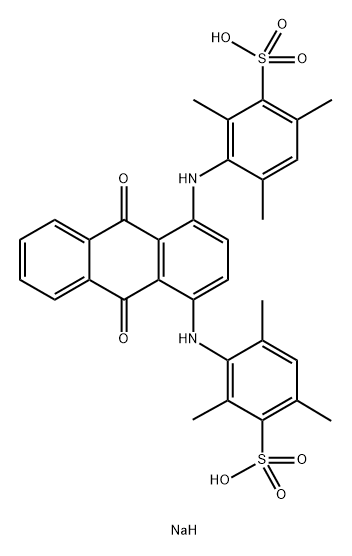2-AMINOANTHRAQUINONE
- CAS NO.:117-79-3
- Empirical Formula: C14H9NO2
- Molecular Weight: 223.23
- MDL number: MFCD00001233
- EINECS: 204-208-4
- SAFETY DATA SHEET (SDS)
- Update Date: 2024-12-18 13:37:16

What is 2-AMINOANTHRAQUINONE?
Chemical properties
2-Aminoanthraquinone forms red or orangebrown needle-shaped crystalline solid. It is used as an intermediate for dyes and pharmaceuticals.
The Uses of 2-AMINOANTHRAQUINONE
2-Aminoanthraquinone was used in fabrication of high performance electrode of supercapacitor based on chemically modified graphene hydrogel. It was used in preparation of ordered assemblies of organic and biological molecules on gold(111) surfaces.
The Uses of 2-AMINOANTHRAQUINONE
2- Amino-3-hydroxyanthraquinone is an intermediate for CI Vat Red 10.
What are the applications of Application
2-Aminoanthraquinone is used in fabrication of high performance electrode of supercapacitor based on chemically modified graphene hydrogel
Definition
ChEBI: 2-Aminoanthraquinone is an anthraquinone.
General Description
2-aminoanthraquinone appears as red needle-like crystals or dark brown granular solid. (NTP, 1992)
Air & Water Reactions
Insoluble in water.
Reactivity Profile
2-AMINOANTHRAQUINONE may react with strong oxidizing agents. Forms salts with mineral acids. Can be acylated or alkylated on the nitrogen atom and nitrated or sulgonated in the ring .
Hazard
Questionable carcinogen.
Health Hazard
ACUTE/CHRONIC HAZARDS: 2-AMINOANTHRAQUINONE may be absorbed through the skin and may cause irritation. It is a positive animal carcinogen. When heated to decomposition 2-AMINOANTHRAQUINONE emits toxic fumes of carbon monoxide, carbon dioxide and nitrogen oxides.
Fire Hazard
Flash point data for 2-AMINOANTHRAQUINONE are not available; however, 2-AMINOANTHRAQUINONE is probably combustible.
Safety Profile
Confirmed carcinogen with experimental carcinogenic, neoplastigenic, and tumorigenic data. Moderately toxic via intraperitoneal route. Mutation data reported. When heated to decomposition it emits toxic NO,. See also AMINES.
Synthesis
Older methods used anthraquinone-2-sulfonic acid as the starting material, replacing the SO3H group. The preferred method is replacement of the chlorine in 2-chloroanthraquinone , .
Potential Exposure
2-Aminoanthraquinone is used as a dye intermediate; in the industrial synthesis of anthraquinone and pharmaceuticals. It is the precursor of five dyes and one pigment, including Color Index Vat Blues 4, 6, 12, and 24; Vat Yellow 1; and Pigment Blue 22. Because AAQ is used on a commercial scale solely by the dye industry, the potential for exposure to the compound is greatest for workers at dye manufacturing facilities. However, no additional data are available on the number of facilities using AAQ. The Consumer Product Safety Commission staff believes that trace amounts of unreacted AAQ may possibly be present in some dyes based on this chemical and in the final consumer product. Exposure even to trace amounts may be a cause for concern. This concern is based on experience with other dyes derived from aromatic amines.
Carcinogenicity
2-Aminoanthraquinone is reasonably anticipated to be a human carcinogen based on sufficient evidence of carcinogenicity from studies in experimental animals.
Shipping
UN3143 Dyes, solid, toxic, n.o.s. or Dye intermediates, solid, toxic, n.o.s., Hazard Class: 6.1; Labels: 6.1-Poisonous materials, Technical Name Required.
Incompatibilities
Keep away from strong oxidizing and reducing agents. Incompatible with oxidizers (chlorates, nitrates, peroxides, permanganates, perchlorates, chlorine, bromine, fluorine, etc.); contact may cause fires or explosions. Keep away from alkaline materials, strong bases, strong acids, oxoacids, epoxides
Properties of 2-AMINOANTHRAQUINONE
| Melting point: | 292-295 °C (dec.)(lit.) |
| Boiling point: | 364.52°C (rough estimate) |
| Density | 1.1814 (rough estimate) |
| refractive index | 1.4700 (estimate) |
| Flash point: | 283°C |
| solubility | ethanol: soluble(lit.) |
| pka | 0.97±0.20(Predicted) |
| form | solid |
| color | Brown |
| Water Solubility | 163ug/L(25 ºC) |
| BRN | 745903 |
| Stability: | Stable. Incompatible with strong oxidizing agents. |
| CAS DataBase Reference | 117-79-3(CAS DataBase Reference) |
| IARC | 3 (Vol. 27, Sup 7) 1987 |
| EPA Substance Registry System | 2-Aminoanthraquinone (117-79-3) |
Safety information for 2-AMINOANTHRAQUINONE
| Signal word | Warning |
| Pictogram(s) |
 Exclamation Mark Irritant GHS07  Health Hazard GHS08 |
| GHS Hazard Statements |
H341:Germ cell mutagenicity H351:Carcinogenicity |
| Precautionary Statement Codes |
P201:Obtain special instructions before use. P202:Do not handle until all safety precautions have been read and understood. P261:Avoid breathing dust/fume/gas/mist/vapours/spray. P264:Wash hands thoroughly after handling. P264:Wash skin thouroughly after handling. P270:Do not eat, drink or smoke when using this product. P271:Use only outdoors or in a well-ventilated area. P280:Wear protective gloves/protective clothing/eye protection/face protection. P281:Use personal protective equipment as required. P308+P313:IF exposed or concerned: Get medical advice/attention. P405:Store locked up. P501:Dispose of contents/container to..… |
Computed Descriptors for 2-AMINOANTHRAQUINONE
New Products
(S)-3-Aminobutanenitrile hydrochloride 4-Methylphenylacetic acid N-Boc-D-alaninol N-BOC-D/L-ALANINOL Tert-butyl bis(2-chloroethyl)carbamate 3-Morpholino-1-(4-nitrophenyl)-5,6-dihydropyridin- 2(1H)-one Furan-2,5-Dicarboxylic Acid Tropic acid 1-Bromo-3,5-Di-Tert-Butylbenzene S-2-CHLORO PROPIONIC ACID ETHYL ISOCYANOACETATE 2-Bromo-1,3-Bis(Dimethylamino)Trimethinium Hexafluorophosphate 4-IODO BENZOIC ACID 3-NITRO-2-METHYL ANILINE 1-(2,4-DICHLOROPHENYL) ETHANAMINE (2-Hydroxyphenyl)acetonitrile 4-Bromopyrazole 2-(Cyanocyclohexyl)acetic acid 4-methoxy-3,5-dinitropyridine 1-(4-(aminomethyl)benzyl)urea hydrochloride 2-aminopropyl benzoate hydrochloride diethyl 2-(2-((tertbutoxycarbonyl)amino) ethyl)malonate tert-butyl 4- (ureidomethyl)benzylcarbamate Ethyl-2-chloro((4-methoxyphenyl)hydrazono)acetateRelated products of tetrahydrofuran








You may like
-
 2-Aminoanthraquinone CAS 117-79-3View Details
2-Aminoanthraquinone CAS 117-79-3View Details
117-79-3 -
 2-Aminoanthracene-9,10-dione CAS 117-79-3View Details
2-Aminoanthracene-9,10-dione CAS 117-79-3View Details
117-79-3 -
 1975-50-4 98%View Details
1975-50-4 98%View Details
1975-50-4 -
 2-HYDROXY BENZYL ALCOHOL 98%View Details
2-HYDROXY BENZYL ALCOHOL 98%View Details
90-01-7 -
 2-Chloro-1,3-Bis(Dimethylamino)Trimethinium Hexafluorophosphate 221615-75-4 98%View Details
2-Chloro-1,3-Bis(Dimethylamino)Trimethinium Hexafluorophosphate 221615-75-4 98%View Details
221615-75-4 -
 61397-56-6 CIS BROMO BENZOATE 98%View Details
61397-56-6 CIS BROMO BENZOATE 98%View Details
61397-56-6 -
 14714-50-2 (2-Hydroxyphenyl)acetonitrile 98+View Details
14714-50-2 (2-Hydroxyphenyl)acetonitrile 98+View Details
14714-50-2 -
 118753-70-1 98+View Details
118753-70-1 98+View Details
118753-70-1